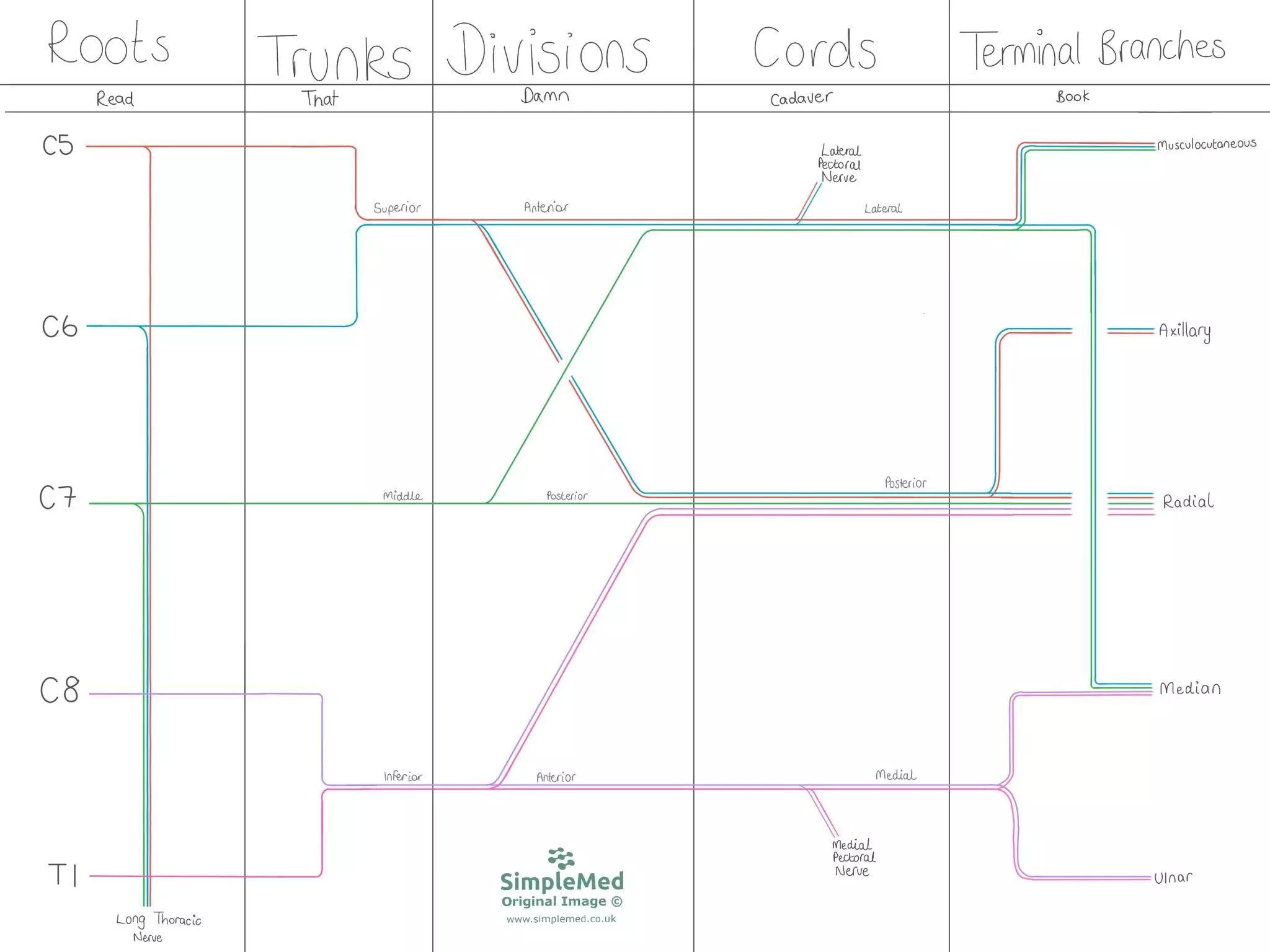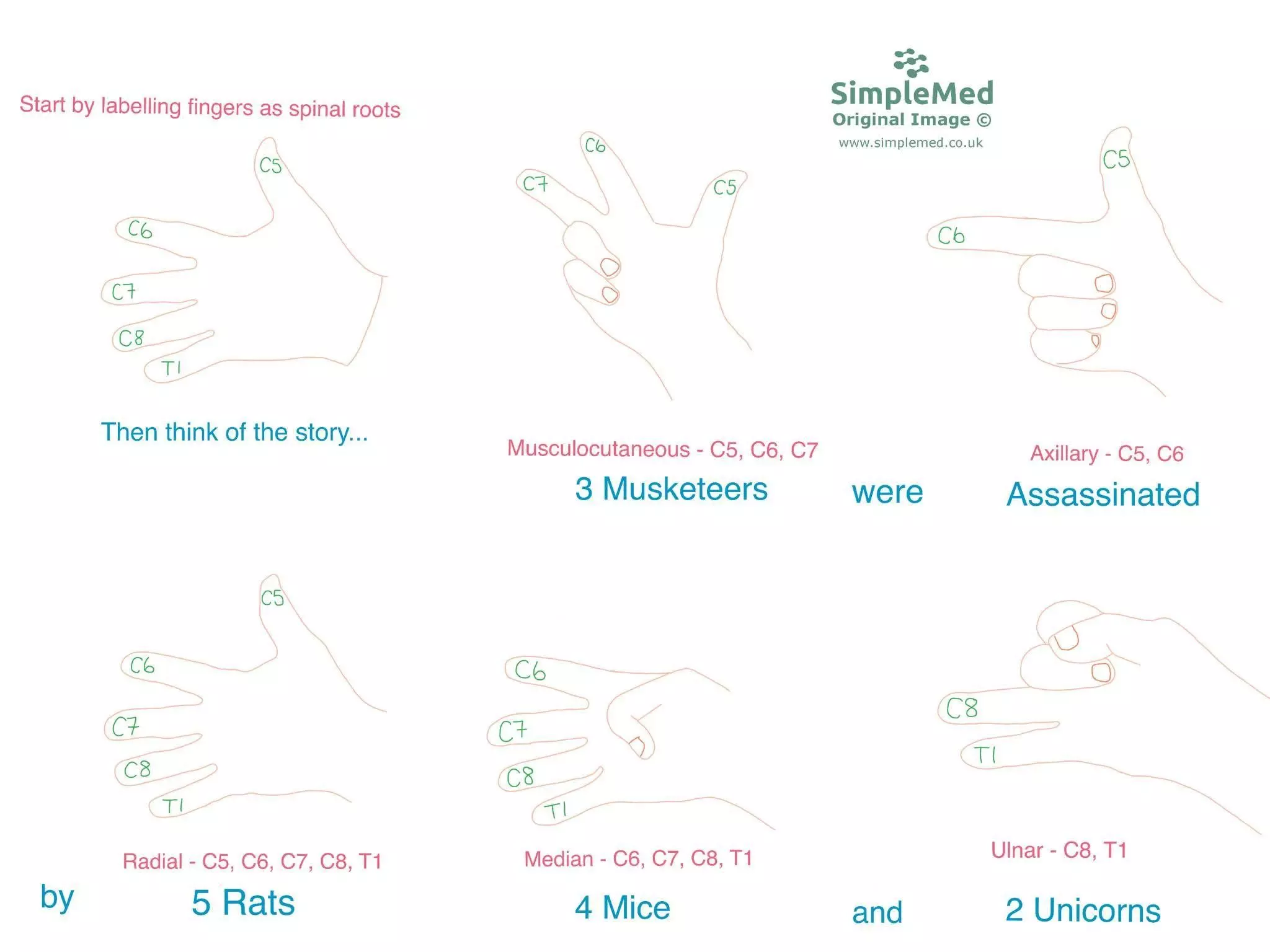Next Lesson - The Lumbar Plexus
Abstract
- The brachial plexus is a convergence of five spinal nerves (C5, C6, C7, C8 and T1) in the axilla that produce five peripheral nerves (musculocutaneous, axillary, radial, median and ulnar) which supply the sensory and motor innervation to the upper limb. The brachial plexus is divided into five segments: roots, trunks, divisions, cords, and terminal branches (also known as peripheral nerves).
- Remembering which spinal nerves contribute to which peripheral nerve can be difficult: the brachial plexus story can help – ‘3 Musketeers were Assassinated by 5 Rats, 4 Mice and 2 Unicorns’. This represents:
- The musculocutaneous nerve having 3 inputs – C5, C6, C7
- The axillary nerve having 2 inputs – C5, C6
- The radial nerve having 5 inputs – C5, C6, C7, C8, T1
- The median nerve having 4 inputs – C6, C7, C8, T1
- The ulnar nerve having 2 inputs – C8, T1
- It is also important to know the sensory and motor functions of each of the peripheral nerves, as well as their path through the upper limb.
Core
The brachial plexus is a network of five spinal nerves that sits in the axilla and supplies the skin and musculature of the upper limb. It is divided into five parts: roots, trunks, divisions, cords and branches.
The nerves that contribute to the brachial plexus are the C5 (cervical nerve 5), C6, C7, C8 and T1 (thoracic nerve 1).
The terminal branches that are the outputs of the brachial plexus are the musculocutaneous nerve, the axillary nerve, the radial nerve, the median nerve and the ulnar nerve. These are also known as the peripheral nerves of the upper limb.

Diagram - The Brachial Plexus. The spinal roots are colour coded to make it easier to see which of the roots contribute to which terminal branches. It is important to note that the median nerve is anterior to the radial and axillary nerves (this is important to note when identifying the nerves in a specimen)
SimpleMed original by Maddie Swannack
Trying to remember which spinal nerves contribute to which peripheral nerve can be challenging. The brachial plexus story and corresponding hand signs can be handy tools to help
The story is: “3 musketeers were assassinated by 5 rats, 4 mice and 2 unicorns” (This order can also be remembered by the acronym MARMU).
The first letters of the underlined words corresponding to the order of the peripheral nerves and the numbers corresponding to the hand signs.
For the hand signs, the fingers on one hand each represent an individual spinal nerve (with the thumb being C5 and the little finger being T1), meaning the story can be attached to specific finger positions to help remember which spinal nerves go into which peripheral nerve (see diagram and explanation below).
The first position is “3 Musketeers” – counting to 3 on the hand (thumb, index and middle finger). This represents the Musculocutaneous nerve, which has the nerve roots of C5, C6 and C7.
The second position is “assassinated” – shown by the finger gun (thumb and index finger). This represents the Axillary nerve, which has the nerve roots C5 and C6.
The third position is “by 5 Rats”, which is all 5 digits. This is for the Radial nerve, which has the nerve roots C5, C6, C7, C8, and T1.
The fourth position is “4 Mice”, which is the index, middle, ring and little fingers. This is for the Median nerve (M and M), which has the nerve roots C6, C7, C8 and T1.
The fifth position is “and 2 Unicorns”, which is the ring and little fingers. This is for the Ulnar nerve, which has the nerve roots C8 and T1.

Diagram - The ‘Brachial Plexus Story’. It is a method for remembering which spinal nerves contribute to which peripheral nerves with the aid of a story and hand position
SimpleMed original by Maddie Swannack
The musculocutaneous nerve is supplied by the spinal nerve roots C5, C6 and C7.
It innervates the sensation of the radial side of the forearm.
It supplies motor function to perform elbow flexion through innervation of the anterior segment of the upper arm – the BBC muscles of biceps brachii, brachioradialis and coracobrachialis.
The path of the musculocutaneous nerve is between the biceps and brachialis (the lateral side of the upper arm).
The axillary nerve is supplied by the spinal nerve roots C5 and C6.
It innervates the sensation of the ‘Regimental badge’ area on the lateral aspect of the shoulder (around the insertion of the deltoid muscle).
It supplies motor function to perform shoulder abduction, flexion and extension through innervation of the deltoid muscle and teres minor.
Its path is short and direct to the deltoid muscle which lies close to the brachial plexus.
The radial nerve is supplied by the spinal nerve roots C5, C6, C7, C8 and T1.
It innervates the sensation of the lateral side of the upper arm, the dorsal side of the forearm, and the radial side of the dorsum of the hand.
It supplies motor function to the posterior segments of the arm and the forearm, performing wrist and elbow extension.
The radial nerve exits the brachial plexus and travels inferiorly, spiralling around the humerus in the radial groove. It then passes anterior to the lateral epicondyle of the humerus, into the forearm.
The median nerve is supplied by the spinal nerve rootsC6, C7, C8 and T1.
It innervates the sensation of the radial side of the palm.
It supplies motor function of the anterior forearm and the some of intrinsic muscles of the hand (thenar eminence), meaning it performs wrist flexion and some movements of the thumb.
This nerve has no branches in the upper arm, then passes through the cubital fossa (medial to the brachial artery). It then passes through the carpel tunnel into the palm of the hand.
The ulnar nerve is supplied by the spinal nerve roots C8 and T1.
It innervates the sensation of the ulnar side of the forearm, palm and ulnar two fingers.
It supplies motor function of the majority of the intrinsic muscles of the hand, including the muscles of the hypothenar eminence. It also supplies motor innervation to the ulnar portion of flexor digitorum profundus.
The ulnar nerve has no branches in the upper arm, passing medially down the humerus and posteriorly to the medial epicondyle of the humerus. At the wrist, the ulnar nerve travels superficially to the flexor retinaculum, and enters the hand via Guyon’s Canal (the ulnar canal).
Other Nerves From the Brachial Plexus
Medial Pectoral Nerve – arises from the medial cord of the brachial plexus and supplies both pectoralis major and pectoralis minor.
Lateral Pectoral Nerve – arises from the lateral cord of the brachial plexus, and supplies pectoralis major only.
Long Thoracic Nerve – originating from the roots of C5, C6 and C7, this nerve is supplies the serratus anterior muscle, which functions to upwardly rotate the scapula to allow the arm to be lifted. If this nerve is paralysed, the pathology ‘Winged Scapula’ occurs.
Edited by: Dr. Ben Appleby
Reviewed by: Dr.Thomas Burnell
- 24790

